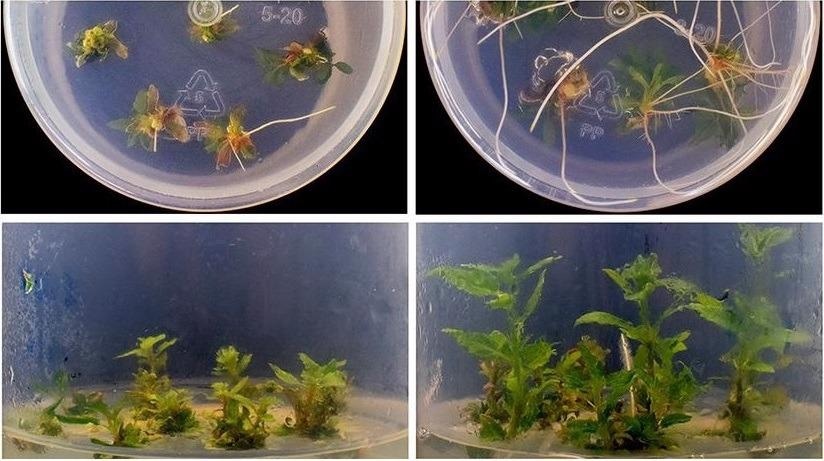Scientists were able to modify the genetic code of living beings ten years ago thanks to a breakthrough technique called CRISPR-CAS9. The instrument, as groundbreaking as it was, had its limits. The initial CRISPR technology can only accomplish one function, similar to the early cell phones that could only do one thing: remove or replace genes in a genomic sequence.
 On the left: poplar sprouts containing CRISPR-edited gene. On the right, poplar sprouts with the same CRISPR edit plus gene enhancements to improve growth. Image Credit: University of Maryland.
On the left: poplar sprouts containing CRISPR-edited gene. On the right, poplar sprouts with the same CRISPR edit plus gene enhancements to improve growth. Image Credit: University of Maryland.
Later variants of CRISPR were designed to allow scientists to modify gene expression by turning them on or off without eliminating them from the genome. However, in plants, each of these functions could only be done individually.
CRISPR-Combo, a technique for editing numerous genes in plants while concurrently modifying the expression of other genes, has been created by scientists from the University of Maryland College of Agriculture and Natural Resources. This new technology will allow genetic engineering combinations to work together to enhance crop breeding and functioning.
The possibilities are really limitless in terms of the traits that can be combined. But what is really exciting is that CRISPR-Combo introduces a level of sophistication to genetic engineering in plants that we haven’t had before.”
Yiping Qi, Study Co-Author and Associate Professor, Department of Plant Science and Landscape Architecture, University of Maryland
The new study will be published in the journal Nature Plants in May 2022.
The advantages of influencing many genes at once can greatly outweigh the advantages of any one manipulation. Consider a blight that destroys wheat fields, threatening farmer’s livelihoods and food security. If scientists could eliminate a gene in wheat that causes it to be sensitive to blight and by turning on genes that shorten the plant’s life cycle and enhance seed production at the same time, they could quickly generate blight-resistant wheat before the disease could do too much harm.
In four separate rounds of testing, Qi and their colleagues showed this form of engineering.
Step one: proving the concept
Qi and their research colleagues have previously created novel CRISPR methods for controlling gene expression in plants and editing many genes at once. However, to build CRISPR-Combo, researchers had to prove that they could execute both genetic engineering operations at the same time without causing problems. Scientists proved this in new research using tomato and rice cells.
As a proof of concept, we showed that we could knock out gene A and upregulate, or activate, gene B successfully, without accidentally crossing over and knocking out gene B or upregulating Gene A.”
Yiping Qi, Study Co-Author and Associate Professor, Department of Plant Science and Landscape Architecture, University of Maryland
Then Qi and his colleagues put CRISPR-Combo to the test on a flowering plant called rockcress (Arabidopsis), which is commonly used as a model for staple crops like corn as well as wheat by scientists.
The researchers altered a gene that makes the plant more herbicide resistant while also activating a gene that triggers early flowering, which results in more seeds being produced. The outcome was an herbicide-resistant rockcress plant that produced eight generations instead of the usual four in a year.
More efficient engineering
The scientists used tissue cultures from poplar trees in their third experiment to show how CRISPR-Combo may boost plant breeding efficiency. Tissue cultures, rather than seeds, are commonly used in plant breeding programs—consider how a plant may regenerate roots and leaves from a single stalk placed in the soil.
Scientists genetically alter stem cells from plant tissue with the potential to develop into whole plants, and the genetic modifications are passed down to the seeds when the plants mature and generate seeds.
Some plants are better than others at regenerating from tissue cultures, making this the single biggest bottleneck in crop genetic engineering. The success rate for certain plants is as low as 1%.
Qi and research colleagues solved the problem by modifying a few features in poplar cells and then activating three genes that enhance plant tissue regeneration.
We showed in poplars that our new method could offer a solution to the tissue regeneration bottleneck, dramatically increasing the efficiency of genetic engineering.”
Yiping Qi, Study Co-Author and Associate Professor, Department of Plant Science and Landscape Architecture, University of Maryland
Hormone-free short cut
Growth hormones, which activate growth-promoting genes, are now required for growing genetically altered plants from tissue cultures. The researchers accelerated the process in rice by using CRISPR-Combo to activate these genes directly.
The outcome was hormone-free gene-edited rice derived from tissue cultures. Tissue cells generated using Qi’s approach expressed more of the altered gene than tissue treated with hormones, according to Qi and his colleagues.
“This method results in a highly efficient genome editing process,” Qi concluded.
After demonstrating that their CRISPR-Combo approach works in a number of plants for numerous reasons, the researchers hope to test it in citrus, carrots, and potatoes to see whether it can be used in fruit, vegetable, or staple crop. Researchers are also developing herbicide-resistant golden rice with improved nutritional value and red rice with more antioxidants.
Source:
Journal reference:
Pan C., et al. (2022) Boosting plant genome editing with a versatile CRISPR-Combo system. Nature Plants. doi.org/10.1038/s41477-022-01151-9.